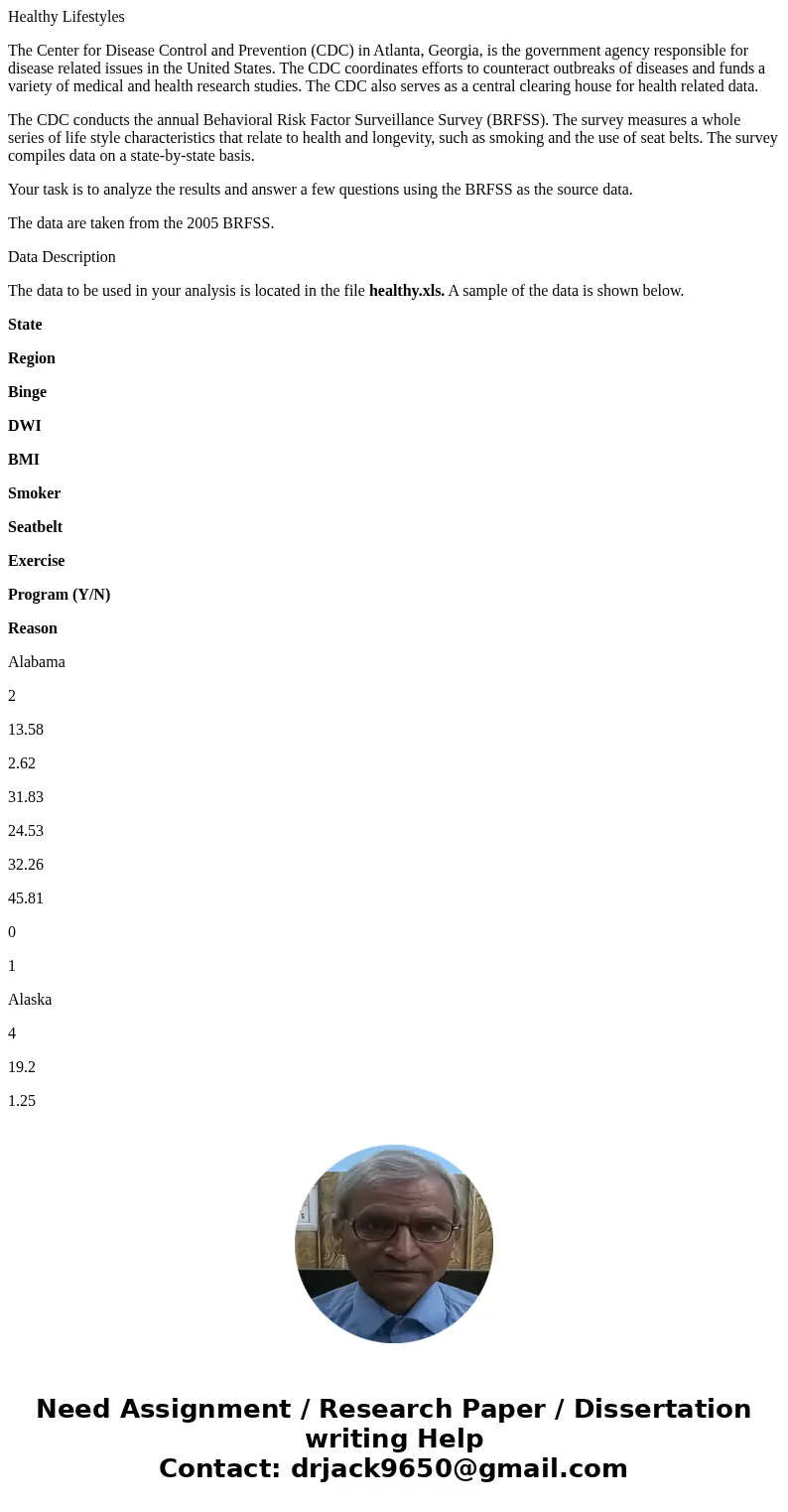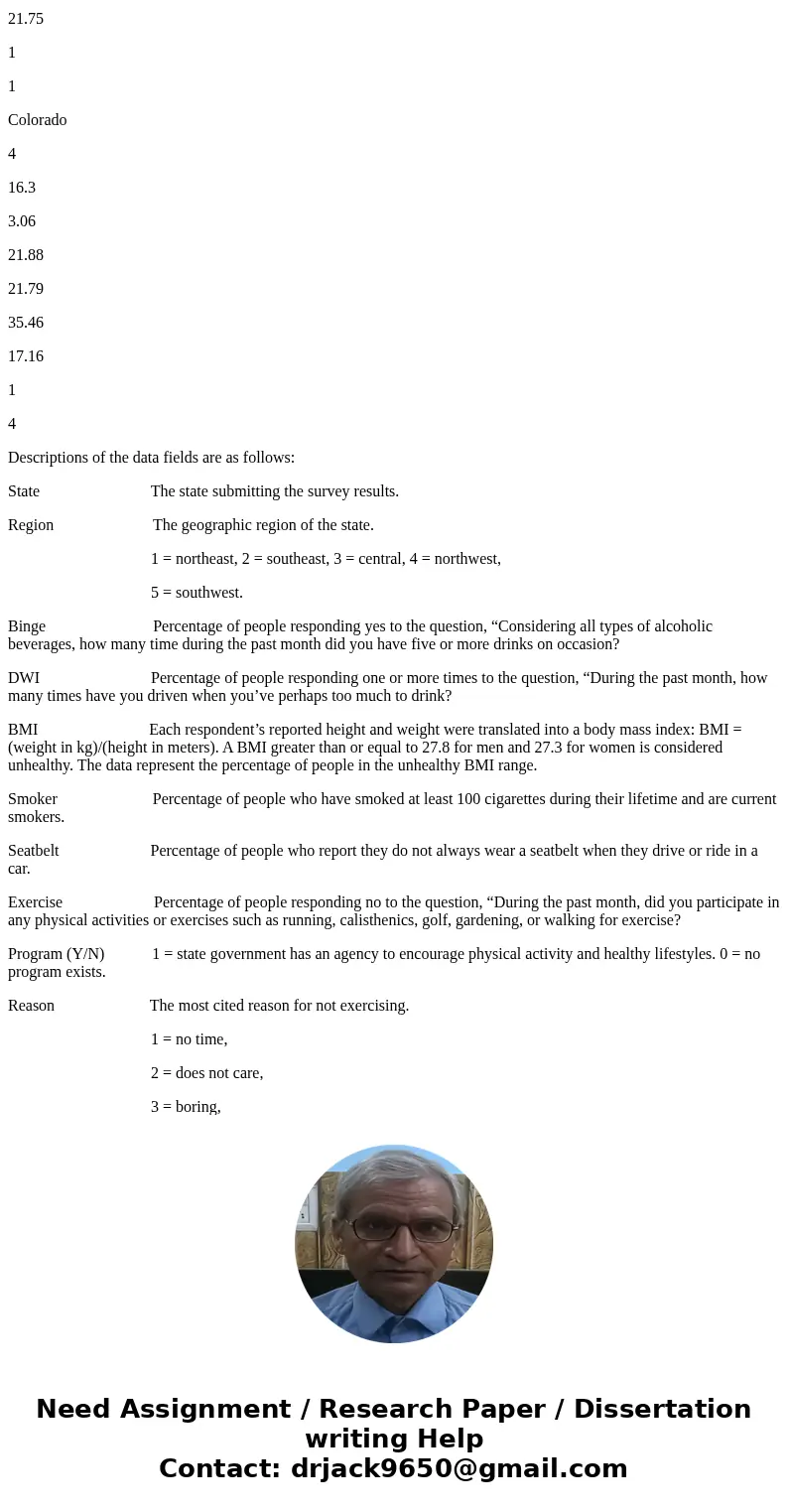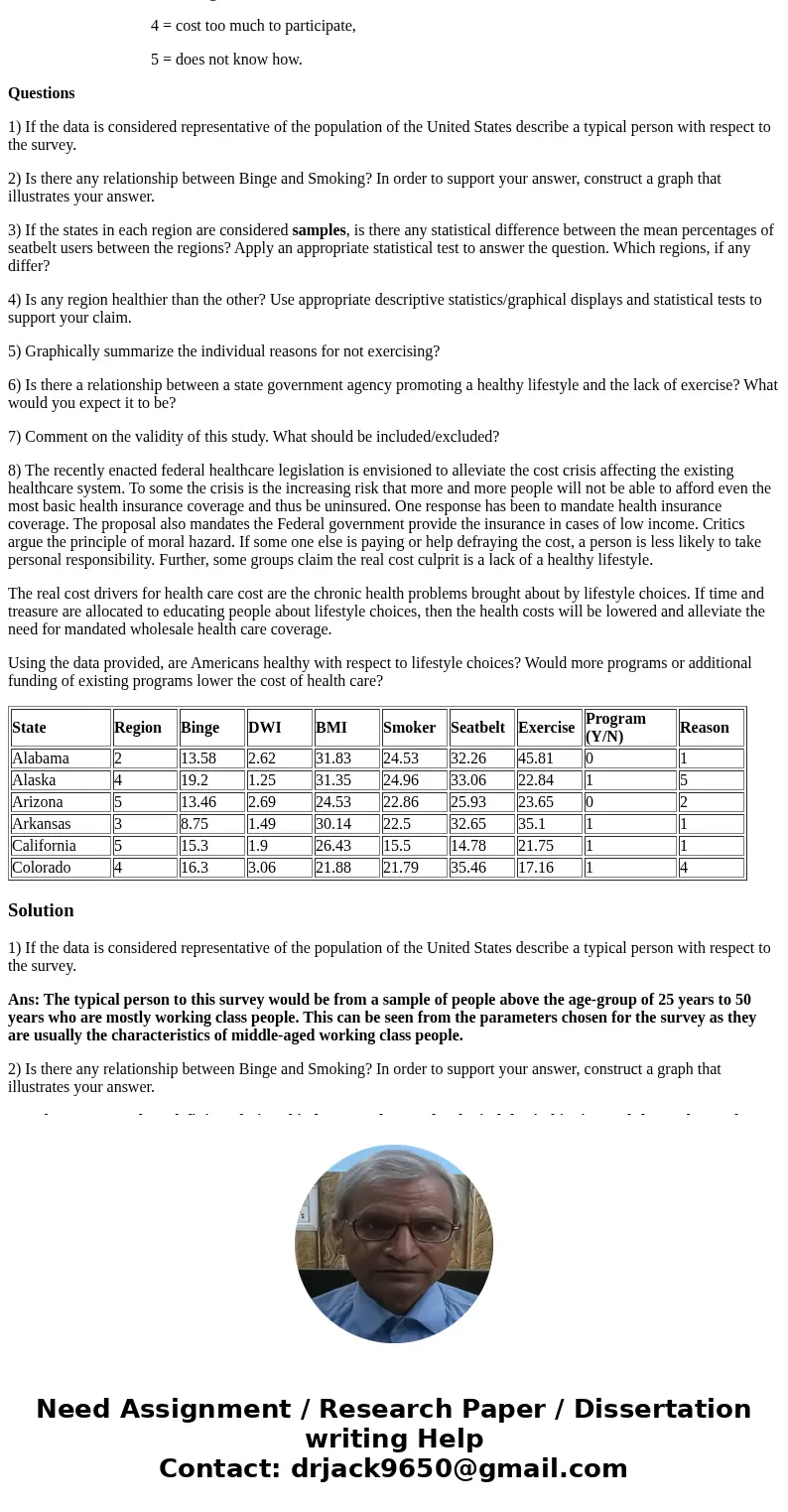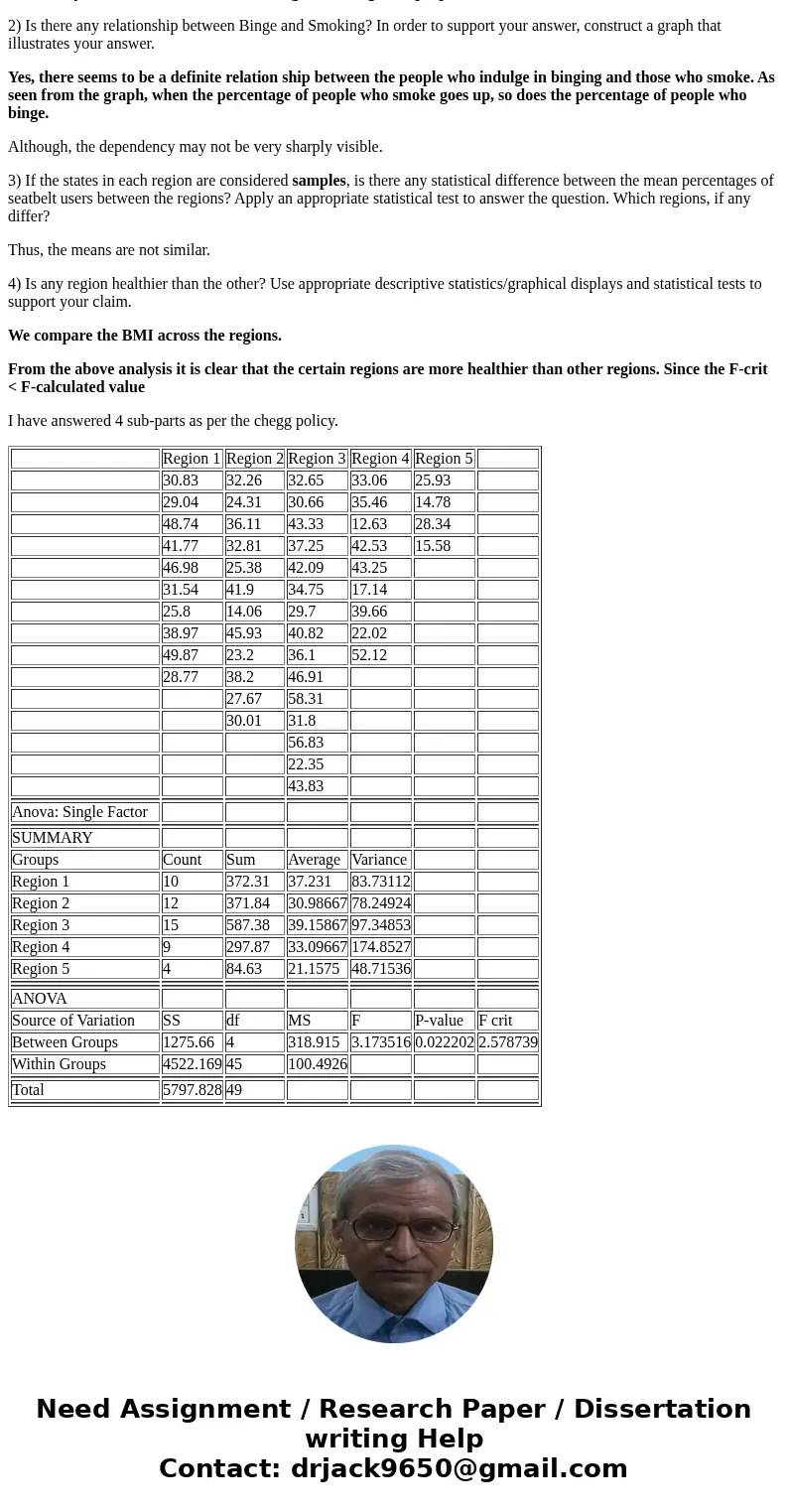Healthy Lifestyles The Center for Disease Control and Preven
Healthy Lifestyles
The Center for Disease Control and Prevention (CDC) in Atlanta, Georgia, is the government agency responsible for disease related issues in the United States. The CDC coordinates efforts to counteract outbreaks of diseases and funds a variety of medical and health research studies. The CDC also serves as a central clearing house for health related data.
The CDC conducts the annual Behavioral Risk Factor Surveillance Survey (BRFSS). The survey measures a whole series of life style characteristics that relate to health and longevity, such as smoking and the use of seat belts. The survey compiles data on a state-by-state basis.
Your task is to analyze the results and answer a few questions using the BRFSS as the source data.
The data are taken from the 2005 BRFSS.
Data Description
The data to be used in your analysis is located in the file healthy.xls. A sample of the data is shown below.
State
Region
Binge
DWI
BMI
Smoker
Seatbelt
Exercise
Program (Y/N)
Reason
Alabama
2
13.58
2.62
31.83
24.53
32.26
45.81
0
1
Alaska
4
19.2
1.25
31.35
24.96
33.06
22.84
1
5
Arizona
5
13.46
2.69
24.53
22.86
25.93
23.65
0
2
Arkansas
3
8.75
1.49
30.14
22.5
32.65
35.1
1
1
California
5
15.3
1.9
26.43
15.5
14.78
21.75
1
1
Colorado
4
16.3
3.06
21.88
21.79
35.46
17.16
1
4
Descriptions of the data fields are as follows:
State The state submitting the survey results.
Region The geographic region of the state.
1 = northeast, 2 = southeast, 3 = central, 4 = northwest,
5 = southwest.
Binge Percentage of people responding yes to the question, “Considering all types of alcoholic beverages, how many time during the past month did you have five or more drinks on occasion?
DWI Percentage of people responding one or more times to the question, “During the past month, how many times have you driven when you’ve perhaps too much to drink?
BMI Each respondent’s reported height and weight were translated into a body mass index: BMI = (weight in kg)/(height in meters). A BMI greater than or equal to 27.8 for men and 27.3 for women is considered unhealthy. The data represent the percentage of people in the unhealthy BMI range.
Smoker Percentage of people who have smoked at least 100 cigarettes during their lifetime and are current smokers.
Seatbelt Percentage of people who report they do not always wear a seatbelt when they drive or ride in a car.
Exercise Percentage of people responding no to the question, “During the past month, did you participate in any physical activities or exercises such as running, calisthenics, golf, gardening, or walking for exercise?
Program (Y/N) 1 = state government has an agency to encourage physical activity and healthy lifestyles. 0 = no program exists.
Reason The most cited reason for not exercising.
1 = no time,
2 = does not care,
3 = boring,
4 = cost too much to participate,
5 = does not know how.
Questions
1) If the data is considered representative of the population of the United States describe a typical person with respect to the survey.
2) Is there any relationship between Binge and Smoking? In order to support your answer, construct a graph that illustrates your answer.
3) If the states in each region are considered samples, is there any statistical difference between the mean percentages of seatbelt users between the regions? Apply an appropriate statistical test to answer the question. Which regions, if any differ?
4) Is any region healthier than the other? Use appropriate descriptive statistics/graphical displays and statistical tests to support your claim.
5) Graphically summarize the individual reasons for not exercising?
6) Is there a relationship between a state government agency promoting a healthy lifestyle and the lack of exercise? What would you expect it to be?
7) Comment on the validity of this study. What should be included/excluded?
8) The recently enacted federal healthcare legislation is envisioned to alleviate the cost crisis affecting the existing healthcare system. To some the crisis is the increasing risk that more and more people will not be able to afford even the most basic health insurance coverage and thus be uninsured. One response has been to mandate health insurance coverage. The proposal also mandates the Federal government provide the insurance in cases of low income. Critics argue the principle of moral hazard. If some one else is paying or help defraying the cost, a person is less likely to take personal responsibility. Further, some groups claim the real cost culprit is a lack of a healthy lifestyle.
The real cost drivers for health care cost are the chronic health problems brought about by lifestyle choices. If time and treasure are allocated to educating people about lifestyle choices, then the health costs will be lowered and alleviate the need for mandated wholesale health care coverage.
Using the data provided, are Americans healthy with respect to lifestyle choices? Would more programs or additional funding of existing programs lower the cost of health care?
| State | Region | Binge | DWI | BMI | Smoker | Seatbelt | Exercise | Program (Y/N) | Reason |
| Alabama | 2 | 13.58 | 2.62 | 31.83 | 24.53 | 32.26 | 45.81 | 0 | 1 |
| Alaska | 4 | 19.2 | 1.25 | 31.35 | 24.96 | 33.06 | 22.84 | 1 | 5 |
| Arizona | 5 | 13.46 | 2.69 | 24.53 | 22.86 | 25.93 | 23.65 | 0 | 2 |
| Arkansas | 3 | 8.75 | 1.49 | 30.14 | 22.5 | 32.65 | 35.1 | 1 | 1 |
| California | 5 | 15.3 | 1.9 | 26.43 | 15.5 | 14.78 | 21.75 | 1 | 1 |
| Colorado | 4 | 16.3 | 3.06 | 21.88 | 21.79 | 35.46 | 17.16 | 1 | 4 |
Solution
1) If the data is considered representative of the population of the United States describe a typical person with respect to the survey.
Ans: The typical person to this survey would be from a sample of people above the age-group of 25 years to 50 years who are mostly working class people. This can be seen from the parameters chosen for the survey as they are usually the characteristics of middle-aged working class people.
2) Is there any relationship between Binge and Smoking? In order to support your answer, construct a graph that illustrates your answer.
Yes, there seems to be a definite relation ship between the people who indulge in binging and those who smoke. As seen from the graph, when the percentage of people who smoke goes up, so does the percentage of people who binge.
Although, the dependency may not be very sharply visible.
3) If the states in each region are considered samples, is there any statistical difference between the mean percentages of seatbelt users between the regions? Apply an appropriate statistical test to answer the question. Which regions, if any differ?
Thus, the means are not similar.
4) Is any region healthier than the other? Use appropriate descriptive statistics/graphical displays and statistical tests to support your claim.
We compare the BMI across the regions.
From the above analysis it is clear that the certain regions are more healthier than other regions. Since the F-crit < F-calculated value
I have answered 4 sub-parts as per the chegg policy.
| Region 1 | Region 2 | Region 3 | Region 4 | Region 5 | ||
| 30.83 | 32.26 | 32.65 | 33.06 | 25.93 | ||
| 29.04 | 24.31 | 30.66 | 35.46 | 14.78 | ||
| 48.74 | 36.11 | 43.33 | 12.63 | 28.34 | ||
| 41.77 | 32.81 | 37.25 | 42.53 | 15.58 | ||
| 46.98 | 25.38 | 42.09 | 43.25 | |||
| 31.54 | 41.9 | 34.75 | 17.14 | |||
| 25.8 | 14.06 | 29.7 | 39.66 | |||
| 38.97 | 45.93 | 40.82 | 22.02 | |||
| 49.87 | 23.2 | 36.1 | 52.12 | |||
| 28.77 | 38.2 | 46.91 | ||||
| 27.67 | 58.31 | |||||
| 30.01 | 31.8 | |||||
| 56.83 | ||||||
| 22.35 | ||||||
| 43.83 | ||||||
| Anova: Single Factor | ||||||
| SUMMARY | ||||||
| Groups | Count | Sum | Average | Variance | ||
| Region 1 | 10 | 372.31 | 37.231 | 83.73112 | ||
| Region 2 | 12 | 371.84 | 30.98667 | 78.24924 | ||
| Region 3 | 15 | 587.38 | 39.15867 | 97.34853 | ||
| Region 4 | 9 | 297.87 | 33.09667 | 174.8527 | ||
| Region 5 | 4 | 84.63 | 21.1575 | 48.71536 | ||
| ANOVA | ||||||
| Source of Variation | SS | df | MS | F | P-value | F crit |
| Between Groups | 1275.66 | 4 | 318.915 | 3.173516 | 0.022202 | 2.578739 |
| Within Groups | 4522.169 | 45 | 100.4926 | |||
| Total | 5797.828 | 49 | ||||





 Homework Sourse
Homework Sourse